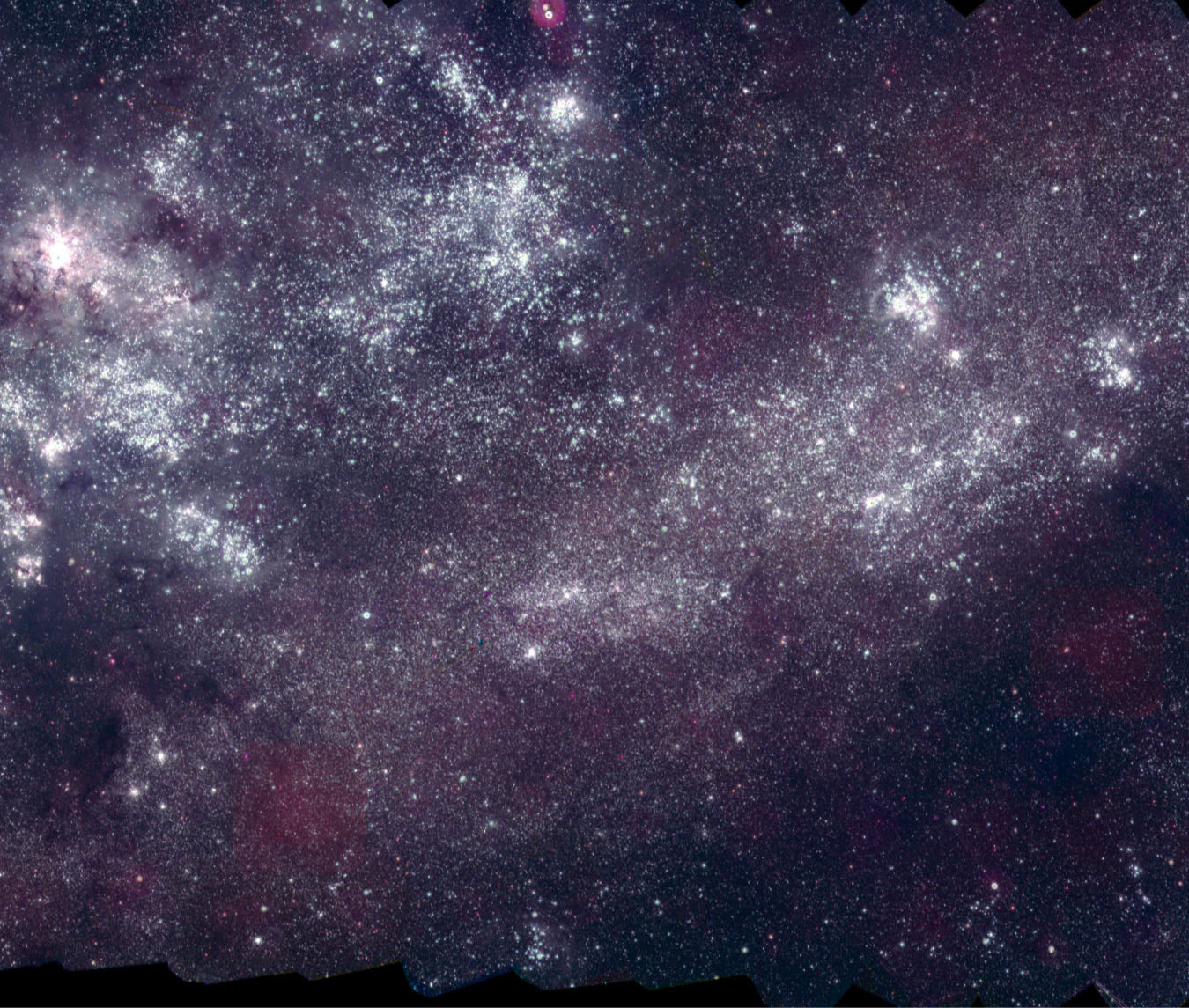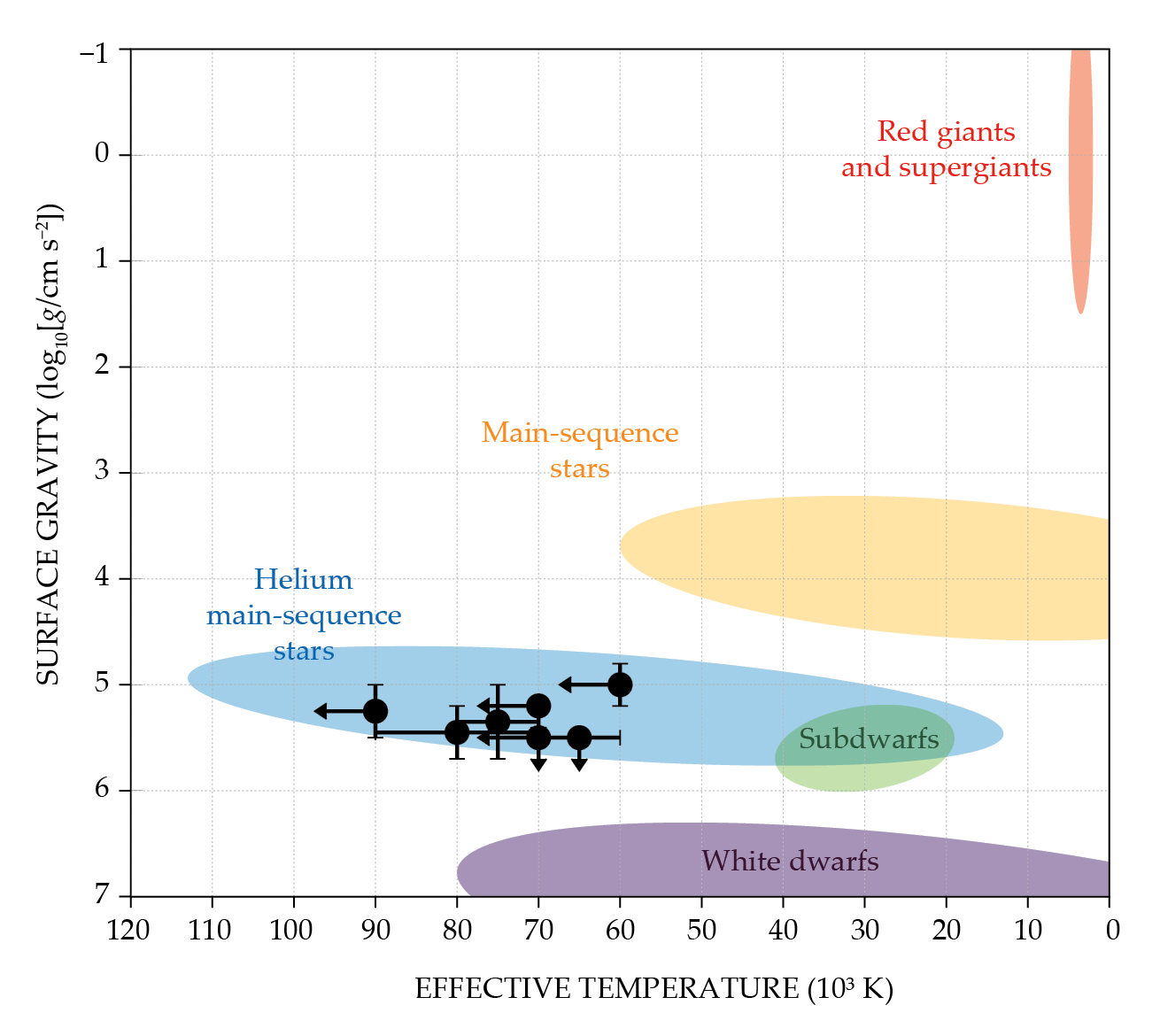Elusive helium stars identified in archival data
DOI: 10.1063/pt.vcnu.qefa
In the gravitational tug of war in a binary system, the hydrogen-rich outer layer of one star can sometimes be pulled away by its companion, leaving behind the compact, hot, and helium-rich core. Stripped helium stars should be abundant in the universe: Theory predicts that about a third of all massive stars should lose their hydrogen-rich outer layer and reach a range of 2–8 solar masses.
Once stripped stars collapse under their own gravitational forces, they’ll generate hydrogen-poor supernovae because of their lack of an outer layer. But despite observing the supernovae and despite years of searching for midsize stripped helium stars, scientists had found only one. (In 2008, astronomers identified it as a 4-solar-mass candidate, 1 and its mass estimate was recently revised to the low end of the range, at 2 solar masses. 2 )
Although stripped stars emit visible light, it’s relatively faint and thus hard to detect. The companion in a binary system may outshine its stripped partner so much that astronomers may even mistake the system for one with only a single star.
Using a new UV-based method, Ylva Götberg (Institute of Science and Technology Austria), Maria Drout (University of Toronto), and their colleagues began an intensive search in 2016 for the elusive stars. They’ve now studied 25 of them, and the new analysis may help explain certain core-collapse supernovae. 3
A serious search
Of the massive stars that explode to produce supernovae, about a third don’t have much hydrogen, “which is actually a lot,” says Drout, “if you’re trying to figure out how a massive star, which should be mostly hydrogen, explodes without it.” Astronomers have observed many helium-rich stars: massive so-called Wolf–Rayet stars larger than 8 solar masses and subdwarfs less than 2 solar masses. But only the elusive midsize stripped stars are consistent with hydrogen-poor supernovae. 4
In 2016 Drout was making observations of hydrogen-poor supernovae as part of her PhD dissertation, which she defended that year. At a meeting of the International Astronomical Union held in New Zealand, she heard a talk by Götberg, a PhD student who was modeling the properties that stripped helium stars should theoretically have.
Götberg says, “I remember Maria saying something like, ‘Are you serious about these stars? I think we can find them.’” The sales pitch was enough for Götberg, and the two began a collaboration. In the latter part of her PhD studies, Götberg focused on understanding the spectral characteristics of midsize stripped stars. Her simulations used mass, the suspected level of ionizing radiation emitted by such stars, and other assumptions to model their effective temperatures, surface gravities, and other properties.
Seeing in UV
A critical insight that Götberg learned from the modeling is that midsize stripped stars should emit and thus be detectable by UV light. 5 Even in binary systems with a bright companion in the visible spectrum, the UV flux from the dimmer stripped star should be substantial. Encouraged by that possibility, the researchers started looking for a UV survey that would give them the data they needed.
Observing the UV sky, however, is challenging. Earth’s atmosphere absorbs a lot of UV light, which is good for people’s health but not for identifying hot stars. Another big problem is dust, which obscures the UV emission from nearby massive stars in the Milky Way. The Hubble Space Telescope captures UV light in high resolution and without impediment by Earth’s atmosphere, but it looks at only relatively small patches of the sky at a time.
“There wasn’t the perfect UV data set that was covering a large enough area of the sky but that also had crisp enough images of individual stars,” says Drout. Between 2010 and 2013, however, NASA’s Neil Gehrels Swift Observatory had collected thousands of UV images from two galaxies: the Large Magellanic Cloud (shown in figure
Figure 1.

A million stars in the Large Magellanic Cloud, 163 000 light-years away, were captured in thousands of UV images by NASA’s Neil Gehrels Swift Observatory, which are overlaid here with visible light. The UV data and optical observations conclusively identify a population of massive helium stars stripped of their hydrogen by their binary companions. (Courtesy of NASA/Swift/S. Immler [Goddard]/ M. Siegel [Penn State].)

One of the coauthors, Bethany Ludwig, had to develop a new method, as part of her PhD thesis, to measure the UV brightness of objects seen in the Swift images. The researchers then used Götberg’s theoretical framework to filter the UV brightness of roughly 500 000 stars and identified hundreds of possible stripped stars.
“We found these candidates in the UV,” says Drout, “but just showing that some star is bright in the UV doesn’t say it’s a stripped star. Really showing that that’s what these are depended on getting the optical spectra and a lot of modeling.”
First class
The researchers selected 25 candidates for further study, and Drout, Götberg, and Ludwig traveled to Chile. There they gathered spectroscopic data from visible light with the Las Campanas Observatory’s Magellan telescopes. From the optical absorption measurements, they concluded that at least 16 of the 25 stars are stripped binaries.
Among other characteristics, the ones most likely to be stripped binaries had a lot of ionized helium and very little hydrogen, which indicates that the stars are extremely hot compared with subdwarfs and main-sequence stars of similar brightness. In addition, the spectral-line shapes were consistent with compact stars in the sought-after range of 2–8 solar masses. Figure
Figure 2.

Helium-rich stars in the range of 2–8 solar masses weren’t conclusively observed until recently, even though they’re the likely progenitors of some common supernovae. The helium-rich stars most likely to be progenitors (black circles) have surface gravities g and effective temperatures consistent with theoretical predictions (blue oval) and are distinct from several other types of stars. (Adapted from ref.

The researchers grouped the 25 candidates into three types according to how much light is emitted by the stripped binary’s companion. The first class, which they’re most confident are supernova progenitors, have relatively dim, obscured companions. The second class has binary stars with roughly equal brightness. The third class has brighter companions, so the stripped stars are revealed only by their UV light, and those nine stars may not be stripped binaries.
The categories offer clues to the nature of the companion star and to the stripped star’s stellar evolution. Some stripped stars are so bright that the companion’s identity remains obscured—it could be, in those cases, a compact neutron star or even a black hole. The other stripped stars are a bit dimmer and may have a common main-sequence star for a companion.
Of particular interest to Drout is what’s next in the life cycle. The stripped binaries could, for example, experience core collapse and explode as hydrogen-poor supernovae, producing neutron stars and black holes. Some of those supernovae could be sources of gravitational waves. Occasionally the newly born neutron star may already have a neutron star companion. If the two merged, rapid nuclear reactions would fuse the periodic table’s heaviest elements.
“Now with these observations,” says Jan Eldridge of the University of Auckland in New Zealand, who organized the conference where Drout and Götberg met, “we can really begin to study and understand helium stars and improve our understanding of the whole universe.”
References
1. J. H. Groh, A. S. Oliveira, J. E. Steiner, Astron. Astrophys. 485, 245 (2008). https://doi.org/10.1051/0004-6361:200809511
2. T. Shenar et al., Science 381, 761 (2023). https://doi.org/10.1126/science.ade3293
3. M. R. Drout et al., Science 382, 1287 (2023). https://doi.org/10.1126/science.ade4970
4. J. J. Eldridge et al., Mon. Not. R. Astron. Soc. 436, 774 (2013). https://doi.org/10.1093/mnras/stt1612
5. Y. Götberg et al., Astron. Astrophys. 615, A78 (2018). https://doi.org/10.1051/0004-6361/201732274
More about the Authors
Alex Lopatka. alopatka@aip.org
